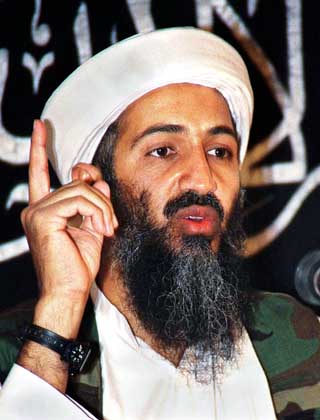After the execution of terror mastermind Osama bin Laden on May 2, U.S. military personnel organized a burial at sea for the Yemeni, complete with Islamic rites. Such an action is in line with a string of others from the U.S. side, that identifies Islam with what is an entirely separate faith, Wahabbism.
Since its discovery three centuries ago, the Wahabbi faith has evolved in a direction toxic to international harmony. Resembling the National Socialist German Workers Party (NSDAP) in its absolutist and exclusivist doctrines, Wahabbism got traction by its success in convincing the Al Saud family in Saudi Arabia that it was the essence of Islam. In fact, its doctrines are a perversion of the mercy, benevolence and compassion of the true faith, which was revealed more than fifteen centuries ago to Prophet Mohammad.
The Al Sauds – in common with most other Middle East heriditary rulers – owe their ascension to power to western countries, in the case of Saudi Arabia, the then British Empire. The harsh dictums of the Wahabbi faith were found to be useful in convincing several unlettered bedouin that the Sufi variant of Islam favored by the Turkish caliphate was the antithesis of the faith, when in fact it expressed its moderate essence quite well. London used the Wahabbis to create a divide between the Caliphate and the Arabs, a policy justified by the rivalry between Turkey and the UK. Subsequently, in the 1950s and until the start of the 1980s, Wahabbism was found effective as an antidote to the Arab nationalism preached by Gamal Abdel Nasser, Ahmed ben Bella and other secular leaders. In the 1980s, the new faith became the core of the CIA-created resistance to the Soviet occupation of Afghanistan.
Since then, however, the ill effects of the policy of relying on fanatics to achieve geopolitical goals has become evident. The world’s “Archipelago of Terror” relies entirely on Wahabbism and its twin, Khomeinism, for recruits. Within Muslim societies, both Wahabbists as well as Khomeinsts are working ceaselessly to create and sustain regimes based on intimidation and injustice. Although the overwhelming majority of Muslims still have the moderate reflexes of the true faith (that revealed to Prophet Mohhammad, in contrast to that created by Abdel Wahab and Ayatollah Khomeini), sadly the US, the U.K. and other western countries persist in regarding Wahabbism as “pure” Islam.
Small wonder that so many Muslims are unable to understand that Wahabbism is not identical to Islam, but is in fact its antipode. It is to Islam what Communism is to Catholicism.
This is why it was wrong to have given a Muslim burial to Bin Laden. The man was not a Muslim but a Wahabbi. His life and beliefs were far removed from the qualities of mercy and compassion that suffuse the Quran. By pretending that those following his toxic creed are Muslims, the U.S. has made more distant the day when the Muslim Ummah will throw off the choking, constricting cloak of Wahabbism-Khomeinism that seeks to entomb the true faith for the benefit of a small elite of fanatics, the elite to which Osama bin Laden belonged.

 Though Osama’s killing is a humongous achievement for the U.S. counterterrorism operations and intelligence services, and is sure to affect the morale of the al- Qaeda foot-soldiers, it is by no means the end of the war on terrorism. As security agencies (particularly in US, Afghanistan, India and Pakistan) prepare for a backlash of the killing, it would be necessary to capture the moment and the momentum, and drill deeper to eradicate more such terrorists. The U.S. cannot relax and retreat now that its primary target has been eliminated; it should push forward even harder.
Though Osama’s killing is a humongous achievement for the U.S. counterterrorism operations and intelligence services, and is sure to affect the morale of the al- Qaeda foot-soldiers, it is by no means the end of the war on terrorism. As security agencies (particularly in US, Afghanistan, India and Pakistan) prepare for a backlash of the killing, it would be necessary to capture the moment and the momentum, and drill deeper to eradicate more such terrorists. The U.S. cannot relax and retreat now that its primary target has been eliminated; it should push forward even harder. India also acquired a host of low-end equipment for counter-insurgency operations and for upgrading the infantry’s combat efficiency. Besides these purchases, the acquisition or manufacture of 126 MMRCA fighter aircraft, almost 1,500 155mm howitzers, about 250 light helicopters, P8I Poseidon maritime reconnaissance aircraft, C-130J Super Hercules aircraft for Special Forces, C-17 Globemaster heavy lift aircraft and many other items of defense equipment, is in the pipeline.
India also acquired a host of low-end equipment for counter-insurgency operations and for upgrading the infantry’s combat efficiency. Besides these purchases, the acquisition or manufacture of 126 MMRCA fighter aircraft, almost 1,500 155mm howitzers, about 250 light helicopters, P8I Poseidon maritime reconnaissance aircraft, C-130J Super Hercules aircraft for Special Forces, C-17 Globemaster heavy lift aircraft and many other items of defense equipment, is in the pipeline.